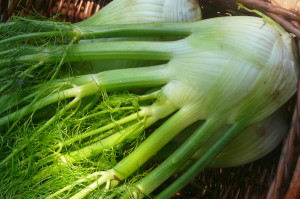Week 14, October 10
Both boxes have: Red Chard, Spinach, Curly Parsley, Apple Cider, Green Cabbage, Fennel
The Standard box also has: Arugula, Bok Choi, Red Potatoes
Your Apple Cider
In the United States, many people use the terms “apple juice” and “apple cider” interchangeably. Some states, however, specify a difference. For example, according to the Massachusetts Department of Agricultural Resources, “Apple juice and apple cider are both fruit beverages made from apples, but there is a difference between the two. Fresh cider is raw apple juice that has not undergone a filtration process to remove coarse particles of pulp or sediment. Apple juice is juice that has been filtered to remove solids and pasteurized so that it will stay fresh longer.” Your cider meets the above criteria for unpasteurized cider.
Unpasteurized cider is generally sold only directly from orchards or farms. In the absence of pasteurization, naturally occurring yeasts in the cider are not killed and they can cause fermentation with time. Even with refrigeration, cider will begin to become slightly carbonated within a week or so and eventually become hard cider as the fermentation process turns sugar into alcohol.
We reiterate—your cider has NOT been pasteurized, and refrigeration is definitely recommended. We can’t say for sure what varieties of apples are in the cider, since Nash spent many years collecting cuttings from the original old homesteads throughout the Sequim-Dungeness Valley, and your cider is a delicious blend of many of them. They were crushed and pressed in an old-fashioned cider press at the farm (below).
Mulled Cider
The perfect seasonal drink, mulled cider can be enjoyed with or without any alcohol. Place your cider in a saucepan, and bring to a boil. Add a cinnamon stick, 2 allspice berries, 2 whole cloves, and half a sliced orange and lower heat. Allow to simmer for 30 minutes. Serve hot. You can also add ginger, or lemon, or top it with a dollop of whipped cream.
Apple Cider-Brined Pork Chops
Apples and pork seem to be a combination that were made for each other. Put 4 cups cider, 2 Tbsp. salt, 2 Tbsp. brown sugar, a 1/4-cup chopped fresh sage, and about an inch of thinly sliced ginger in a pot and simmer for a few minutes. Allow to cool. Add 2-4 pork chops (Nash’s, of course!) and marinate for several hours. Cook the chops however you like—grill, broil, or in a pan on the stovetop. Serve with some sautéed green cabbage, and roasted red potatoes.
Chicken with Cider & Mustard
Cook two chicken breasts in a tablespoon of butter in a heavy skillet. Remove from the pan. Add one-half cup cider and 1 teaspoon Dijon mustard to the pan and mix well. Add the chicken and coat with the mixture. Serve on rice, and sprinkle with pecan halves and finely chopped parsley.
About Your Fennel
The fennel in your box comes from a new farm in our area, River Run Farm in Sequim. We are proud to support the young people who are now farming the excellent soil adjacent to the Dungeness River just south of Woodcock Road.
Fennel is related to parsley, carrots, dill and coriander. It originated in the Mediterranean region, and, as might be expected, it is used extensively in the cuisines of France, Italy and Greece. It has a subtle licorice scent and flavor and is one of the three main herbs used in the preparation of absinthe, an alcoholic drink that was popular in 19th century Europe.
Europeans disseminated fennel around the world and it grows well in dry soils, especially in coastal areas. It has been so successful that it is considered an invasive species in parts of Australia and the U.S. Nonetheless, the bulb, stems, fronds and seeds are all widely used in many culinary traditions of the world, including India, the Middle East, and China.
Fennel is delicious raw or cooked. The bulb can sliced and sauteed, stewed, braised, grilled, added to soups and pizza, used for garnishes, and eaten raw as part of a salad. The delicate fronds are elegant as a garnish for creamy soups, pastas or added to egg dishes for a touch of sweetness. The stems can be boiled to make an herbal tea, or added to sautes, soups, stir-fries or veggie stock.
Fennel contains many phytonutrients that are powerful antioxidants. Its main benefits are anti-inflammatory and immune system support. It is an excellent source of vitamin C, folate, and potassium.
A source of some really intriguing-sounding fennel recipes can be found at The Huffington Post.



